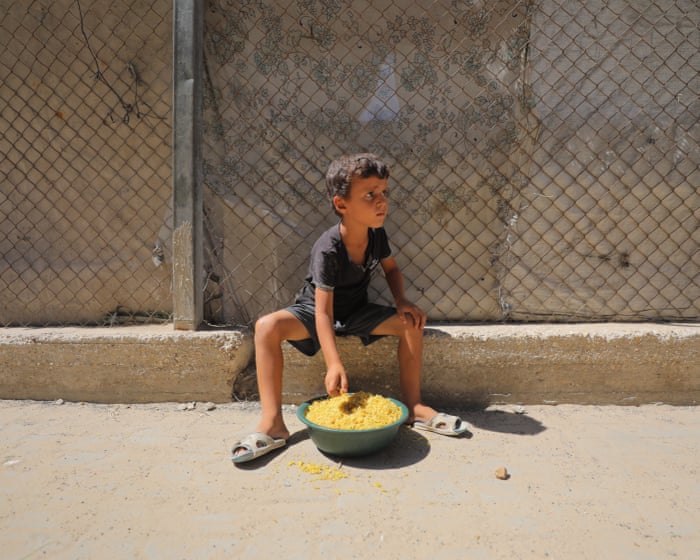In just two weeks last month, UNICEF clinics in Gaza admitted more than 7,000 children under five to recovery programmes for acute malnutrition. The full count for August is still being compiled but is expected to exceed 15,000 new cases—more than seven times the number recorded in February.
Last month, a famine was declared in Gaza City, in the northern part of the devastated territory. Officials from UNICEF say other towns farther south are “fast catching up.”
Tess Ingram, a UNICEF spokesperson who recently spent time in Gaza City, stated, “On the ground, it is crystal clear that people are starving. A famine is unfolding in Gaza City, and Deir al-Balah and Khan Younis [two southern cities] are not far behind.”
Ingram spoke with a malnourished mother in Gaza City who was unable to breastfeed her eight-month-old, also malnourished. “She and her husband were sharing a cup of rice a day. The situation is horrific,” Ingram added.
Gaza City, once a bustling commercial and cultural center, is now the target of a new Israeli offensive that threatens to displace its estimated one million or more residents. Israeli officials have called the city a Hamas “bastion.”
The Israeli military has ordered Palestinians to leave Gaza City for the south ahead of the assault but has not provided a timeline. Previous statements indicated the offensive would not be announced in advance.
This operation risks displacing hundreds of thousands of Palestinians already weakened by nearly two years of bombing, malnutrition, and now famine. Many have been displaced before, some multiple times, and some Gaza City residents say they will refuse to move again.
In May, Israel eased a two-month total blockade on supplies entering Gaza, but aid remains insufficient. UN agencies are working to overcome major logistical challenges, ongoing Israeli restrictions, and bureaucratic hurdles to supply a small number of community kitchens and bakeries. Private commercial trucks bring limited amounts of rice, sugar, instant noodles, and other dry goods. Fresh vegetables are rare and can cost up to $50 (£37) per kilogram—a price few can afford.
“The story is the same—a bowl a day from the community kitchen, almost always lentils or rice, shared among the family, with parents skipping meals so children can eat. There are no nutrients, no other options. Aid is scarce, and the market is far too expensive,” said Ingram.
Residents describe facing an “impossible choice”: stay in makeshift homes in Gaza City and hope to survive a possible Israeli attack, or flee to severely overcrowded coastal areas where space, services, water, and healthcare are almost nonexistent.
In al-Mawasi, the main coastal zone designated by Israel for those fleeing Gaza City, aid workers say hundreds of thousands of displaced people are already crowded onto sandy dunes and fields. A tent-sized plot on any available land costs around $300 per month, and there is little room for newcomers.
“Water supply is insufficient, the tents and shelters are very flimsy, there’s no proper waste disposal, no shade, and no space for more people. It’s totally unfit for human habitation even now,” said one aid worker in al-Mawasi.
Israeli officials blame the UN for failing to distribute aid and have repeatedly claimed that Hamas steals much of the assistance. However, an internal U.S. government report found these claims to be untrue.
Last month, the Integrated Food Security Phase Classification (IPC), a globally recognized body that assesses food insecurity and malnutrition severity,A UN nutrition expert has confirmed that three critical conditions for famine are now present in Gaza City. Children are especially at risk. The number of children under five treated for acute malnutrition at UNICEF clinics in Gaza rose from 2,000 in February to 5,500 in May, and reached over 15,000 by July.
During this period, UNICEF screened 144,000 children under five, up from 82,000. Cases of severe acute malnutrition—the most critical category—increased from 20 in March to 40 in July, though this was a decrease from a peak of over 50 the previous month.
Despite objections from within the military leadership, Israeli Prime Minister Benjamin Netanyahu is moving forward with a new offensive. Significant differences remain between Israel’s terms and those of Hamas, making a ceasefire unlikely in the near future.
Far-right members of Netanyahu’s coalition have threatened to withdraw support if Israel makes concessions to secure the release of the roughly 50 hostages still held in Gaza, fewer than 20 of whom are believed to be alive.
On Friday, the Israeli military announced plans to target buildings in Gaza City identified as Hamas facilities, including observation posts, sniper positions, and command centers.
Last week, officials stated that Israel will halt airdrops over Gaza City and reduce the number of aid trucks entering the north as the offensive intensifies and preparations are made to order hundreds of thousands of people to move south. The UN and aid organizations have emphasized that current measures fall far short of the 600 trucks of aid needed daily in Gaza.
The conflict began after Hamas’s October 2023 attack on Israel, which killed 1,200 people, mostly civilians, and resulted in 250 hostages being taken. Israel’s subsequent offensive has killed more than 63,000 people, the majority civilians, and caused widespread destruction across Gaza.
Clea Skopeliti contributed to this report.
Frequently Asked Questions
Of course Here is a list of FAQs about the topic designed to be clear and helpful
General Beginner Questions
Q What does this headline actually mean
A It means that in just 14 days medical workers provided special food and care to over 7000 very young children in Gaza who were suffering from severe hunger and a lack of essential nutrients which is a condition called malnutrition
Q Why is malnutrition so dangerous for young children
A For children under five malnutrition is extremely dangerous because their bodies and brains are developing rapidly Without proper nutrients it can lead to stunted growth developmental delays a weakened immune system and in severe cases death
Q What kind of treatment do these children receive
A Treatment typically involves therapeutic foods which are highenergy nutrientpacked pastes along with rehydration solutions for diarrhea and sometimes medical care for other illnesses they have because their bodies are weak
Q Why is this happening in Gaza specifically
A Gaza is experiencing a severe humanitarian crisis due to ongoing conflict This has led to a massive shortage of food clean water and fuel which has collapsed the healthcare system and made it nearly impossible for families to access basic necessities
Intermediate CauseFocused Questions
Q Is malnutrition a new problem in Gaza
A No malnutrition and food insecurity have been longstanding issues in Gaza due to a longterm blockade However the current conflict has dramatically worsened the situation to catastrophic levels pushing it into a fullscale famine
Q What are the main causes of this malnutrition crisis
A The primary causes are
Lack of food access Extremely limited aid trucks are able to enter and what is available is too expensive for most people
Collapse of healthcare Hospitals and clinics have been damaged lack power and are out of critical supplies
Lack of clean water and sanitation This leads to diseases like diarrhea which prevents children from absorbing nutrients from the little food they do get
Q Who is providing this treatment




